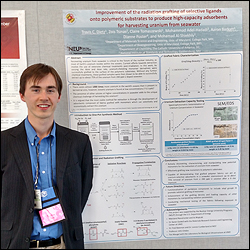News Story
MSE Grad Student Recognized for Work on Polymer Sheets that Filter Uranium from Seawater

Department of Materials Science and Engineering (MSE) graduate student Travis Dietz with a poster on his research.
Department of Materials Science and Engineering (MSE) graduate student Travis Dietz presented his work on harvesting uranium from seawater at the plenary session of the Council on Ionizing Radiation and Measurements and Standards’ (CIRMS) 23rd annual meeting, held at the National Institute of Standards and Technology (NIST) April 27-29. The talk described a project that recently earned Dietz a CIRMS Student Grant Award.
For several years, members of MSE professor Mohamad Al-Sheikhly’s research group, including Dietz, have pursued the idea of “mining the sea for uranium.” About 1000 times more uranium is dissolved in seawater than is found in the earth, but collecting it on a commercial scale has been hampered by lack of an affordable and efficient way to do it. Despite an extremely low concentration (about 3 parts per billion), obtaining uranium from seawater is still an attractive alternative to mining because it can be accomplished using a passive process that requires no pumping, electricity, or mining.
That process, developed and utilized in a Japanese study concluded in 2001, uses huge sheets of specially treated synthetic fabric or plastic to filter uranium ions from seawater.
While this approach has no known environmental impact and is far less hazardous for workers, the fabrics have so far had a very limited lifespan and have been too inefficient to justify their cost. For years, research groups around the world have tried to optimize their materials in order to turn the concept into a commercially viable technology.
In most approaches, including Dietz’s, radiation is used to graft uranium ion-binding monomers or other chemicals to the fabric.
To accomplish this, he has to overcome two challenges: One is that many of the monomers he and other researchers use are not very soluble in water, but soaking the fabric is part of the irradiation process. The other is that the final preparation, or “finishing” of the fabric to make it ready to use has typically required additional chemical treatments, which increases costs and could lead to significant amounts of industrial waste if the fabrics were produced on a commercial scale.
While the monomers’ poor solubility in water might sound like a good thing for something that’s going to be put into the ocean, it creates a manufacturing problem.
“The fabric is put into a solution of water and monomer for the grafting process, but only a limited amount of the monomer can be dissolved,” Dietz explains. “The more we can dissolve in the solution, the more we can graft to the fabric, which increases performance and efficiency enough to justify the effort. We’ve been able to work around the low solubility problem through the use of biocompatible surfactants and manipulation of the irradiation process.”
Ideally, after the fabric is irradiated and the monomers have been grafted, they will stay put (or at least take a much longer time to wash off) in seawater. But that doesn’t mean they’re ready to bind to uranium. Dietz says that other proposed processes use a corrosive base treatment to reinforce the grafting and chemically “activate” the monomers before the product is ready to go.
“We identified monomers with molecular structures that allow them to be grafted to fabric and to bind to uranium and optimized our irradiation process to eliminate the need for additional chemical processing. All we need to do to make our fabric ready to extract uranium is wash off anything not grafted to it with some biodegradable soap and water.”
Solving these production and scale-up problems is important to the future of energy resources, says Dietz, who is continuing to search for and develop more efficient monomer-grafted fabrics. “This work will be important for the continuation and expansion of our nation’s nuclear energy resources. Developing the ability to extract uranium efficiently from our oceans and seas will extend our ability to generate power from nuclear energy far into the future.”
Published May 1, 2015









